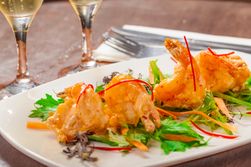
Tempura is a term in Japanese cuisine for battered and deep-fried foods. You may be familiar with the word from sushi menus, due to the popularity of tempura rolls. However, this cooking method can be used to prepare an overwhelming variety of foods, such as fish, seafood, and vegetables. Learn more below about the history of tempura and how it’s made.
Understanding Tempura
How It Began
The seeds for the cooking method eventually known as tempura entered Japanese cuisine in the 16th century, when Portuguese missionaries and merchants taught chefs to deep fry food in oil. The practice became mainstream in the Edo period (1603-1868) when frying oil became more affordable. The method was used first to prepare street food. During the Meiji period (1868-1912), tempura dishes started being served as a full meal accompanied by noodles or rice. It’s still popular in this form – “tendon” is a term for a bowl of steamed rice with tempura.
How It’s Prepared
 The batter (koromo) is mixed fresh with cold water, with some slight lumps left in the batter. Those lumps and air bubbles create tempura’s signature crisp texture. After the ingredients are prepared by being cut into shapes that will cook evenly, they’re then dipped into the batter for a thin coating. The food is then fried at very high temperatures in oil — vegetable, sesame, rice bran, and cottonseed oil are all potential options. The finished dish can be served with salt or a dipping sauce made of mirin, dashi broth, and soy sauce (tentsuyu).
The batter (koromo) is mixed fresh with cold water, with some slight lumps left in the batter. Those lumps and air bubbles create tempura’s signature crisp texture. After the ingredients are prepared by being cut into shapes that will cook evenly, they’re then dipped into the batter for a thin coating. The food is then fried at very high temperatures in oil — vegetable, sesame, rice bran, and cottonseed oil are all potential options. The finished dish can be served with salt or a dipping sauce made of mirin, dashi broth, and soy sauce (tentsuyu).
Tempura is a delicious part of Japanese cuisine that you won’t want to miss. Try it at Kabuto Japanese Steakhouse & Sushi Bar in Greensboro, NC. This sushi and hibachi grill has a large menu with selections from Japanese cuisine that appeal to all tastes. Their talented chefs will give you a show while they prepare your order using fresh ingredients and authentic recipes. Preview their menus online and call (336) 852-5550 to make a lunch or dinner reservation.
About the Business
Have a question? Ask the experts!
Send your question

